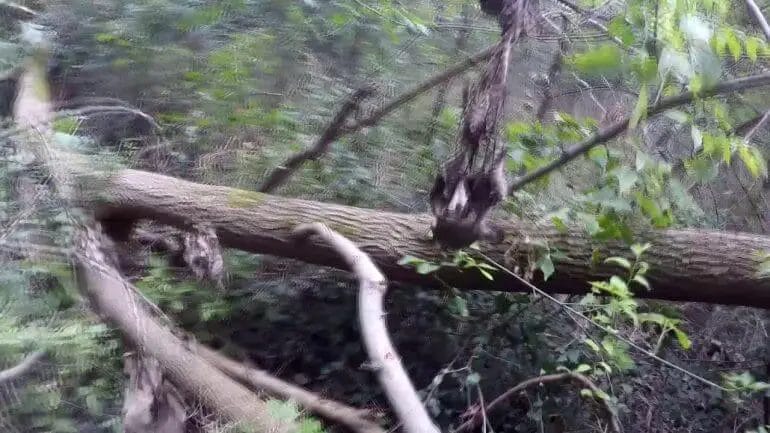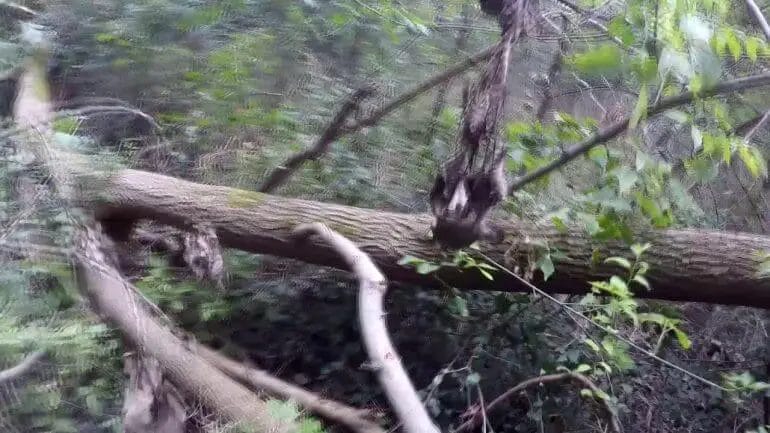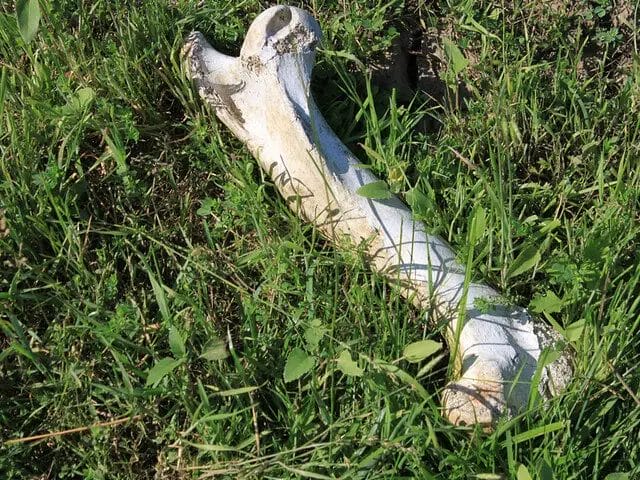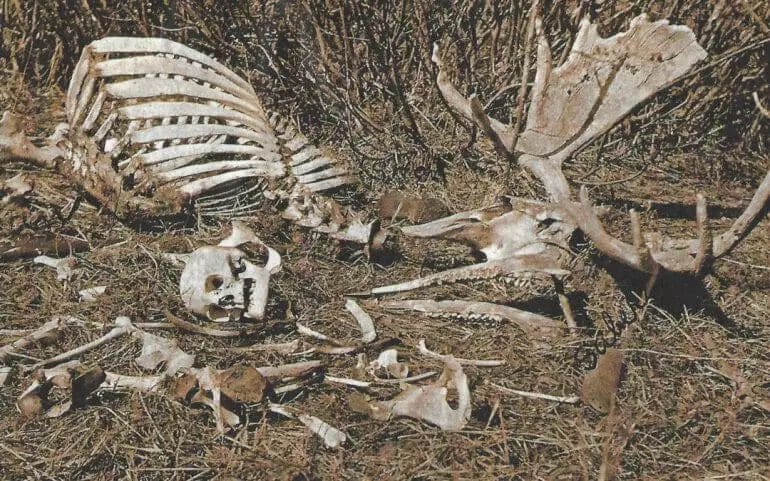When exploring the woods, stumbling upon bones can be an intriguing and mysterious discovery. Whether you are an avid hiker or a nature enthusiast, coming across bones in the wild can provide valuable insights into the ecosystem and animal behavior. In this article, we will guide you on how to find bones in the woods, including tips on identifying them, ethical considerations, and the importance of preserving these natural artifacts.

Tools and Techniques: Essential Tips for Searching and Digging for Bones
When it comes to paleontology, searching for and excavating bones requires a specialized set of tools and techniques. These tools not only help in locating and identifying fossils but also ensure their safe extraction and preservation. In this section, we will explore some essential tips for searching and digging for bones, along with the tools that are commonly used by paleontologists.

1. Research and Planning
Before embarking on a bone-digging expedition, it is crucial to conduct thorough research and planning. This involves studying the geological history of the area, identifying potential fossil-rich sites, and understanding the types of fossils that are likely to be found. By gathering as much information as possible, you can increase your chances of a successful excavation.
2. Mapping and Surveying
Prior to commencing the dig, it is essential to create detailed maps and conduct surveys of the site. Mapping helps in identifying specific areas where fossils may be buried, while surveying enables you to record the exact locations of any finds. This information is crucial for future reference and scientific documentation.
3. Excavation Tools
Various tools are used in the process of excavating fossils. Some of the key tools include:
- Shovels and Picks: These tools are used for removing overburden and loosening the sediment around the fossils.
- Brushes and Dental Picks: These delicate tools are used for carefully brushing away sediment and dirt from the fossil surfaces.
- Sieves and Screens: These tools help in separating smaller bone fragments and other artifacts from the surrounding sediment.
- Chisels and Jackhammers: These heavy-duty tools are used for breaking larger rock formations and extracting fossils embedded within them.
4. Field Notes and Documentation
During the excavation process, it is important to keep detailed field notes and document the findings. This includes recording the stratigraphy of the site, capturing photographs, and making sketches of the surrounding geological features. Proper documentation ensures that the excavation can be accurately reconstructed and analyzed in the future.
5. Handling and Preservation
Once the fossils are unearthed, proper handling and preservation techniques must be employed to ensure their long-term survival. This includes carefully wrapping and labeling each specimen, using specialized containers, and protecting them from any potential damage during transportation and storage.
6. Collaborating with Experts
Paleontology is a collaborative science, and it is often beneficial to seek the expertise of fellow paleontologists and specialists. By collaborating with experts, you can gain valuable insights, receive guidance on identification and preservation techniques, and contribute to the broader scientific community.
7. Ethical Considerations
Lastly, it is essential to approach paleontological excavations with ethical considerations in mind. This includes adhering to local regulations and obtaining any necessary permits, respecting the environment, and ensuring that the site is properly restored after the excavation is complete.
In summary, successful bone searching and excavation require meticulous research, careful planning, and the use of specialized tools and techniques. By following these essential tips and employing the right tools, you can contribute to the fascinating field of paleontology and help uncover the secrets of the past.

Preservation and Documentation: Proper Methods for Handling and Collecting Bones
When it comes to handling and collecting bones, proper preservation and documentation methods are crucial to ensure the integrity and accuracy of the specimens. Whether you are an archaeologist, a paleontologist, or a bone collector, following these guidelines will help preserve the bones for future study and research.
1. Handling Bones
When handling bones, it’s important to exercise caution and follow best practices to avoid any damage or contamination. Here are some key points to keep in mind:
- Wear gloves: Always wear gloves when handling bones to protect them from oils and acids present in your skin.
- Use clean tools: Utilize clean and sterile tools, such as brushes and tweezers, to handle bones and avoid introducing any foreign substances.
- Avoid direct contact: Handle bones by their sturdy areas, such as the shaft or the ends, to prevent any unnecessary stress or pressure on fragile sections.
- Minimize movement: Try to minimize movement and jostling of bones, as this can lead to breakage or additional damage.
2. Cleaning and Preservation
Proper cleaning and preservation techniques are essential to maintain the condition and structural integrity of the bones. Here are some steps to follow:
- Remove dirt and debris: Gently remove any dirt or debris from the bones using a soft brush or toothbrush. Avoid using water or harsh chemicals unless specifically recommended by experts.
- Air-dry bones: Allow the bones to air-dry completely before storing them. This helps prevent the growth of mold or decay.
- Store in suitable containers: Use acid-free tissue paper or archival-quality plastic bags to store the bones. These materials help maintain the proper moisture levels and prevent any chemical reactions.
- Control temperature and humidity: Store the bones in a cool, dry, and stable environment to prevent degradation. Avoid exposure to direct sunlight or extreme temperature fluctuations.
3. Documentation
Accurate documentation is crucial for proper identification and analysis of bones. Here are some key points to consider:
- Record important details: Document important information such as the location where the bones were found, the date of discovery, and any associated artifacts or geological features.
- Take photographs: Capture detailed photographs of the bones from multiple angles. This helps preserve visual information and aids in future analysis.
- Create detailed descriptions: Write detailed descriptions of the bones, noting their size, shape, color, and any unique characteristics. Use standardized terminology to ensure consistency.
- Label specimens: Label each bone specimen with a unique identifier and include relevant information to avoid any mix-ups or confusion.
4. Ethical Considerations
When engaging in bone collection, it’s important to adhere to ethical guidelines to ensure the respectful treatment of human remains and the preservation of cultural heritage. Some ethical considerations include:
- Comply with legal regulations: Familiarize yourself with local laws and regulations regarding the collection and possession of bones. Obtain any necessary permits or permissions before engaging in bone collection.
- Show respect: Treat bones with respect and reverence, considering the cultural and historical significance they may hold. Avoid engaging in activities that may cause damage or disturbance to burial sites.
- Collaborate with experts: Seek guidance from professionals, such as archaeologists or paleontologists, to ensure that your bone collection activities align with best practices and contribute to scientific knowledge.
In summary, when handling and collecting bones, it is crucial to follow proper preservation and documentation methods to protect the integrity and historical value of the specimens. By handling bones with care, cleaning and preserving them appropriately, accurately documenting their details, and adhering to ethical considerations, bone collectors and researchers can contribute to the advancement of knowledge in the fields of archaeology, paleontology, and cultural heritage.

Common Challenges: Overcoming Obstacles When Searching for Bones in the Woods
Searching for bones in the woods can be an exciting and rewarding endeavor. However, it is not without its challenges. In this section, we will explore some common obstacles that bone enthusiasts may encounter during their search and discuss strategies for overcoming them.
1. Dense Vegetation
One of the main challenges when searching for bones in the woods is dealing with dense vegetation. Thick undergrowth and tangled foliage can make it difficult to navigate through the forest and locate potential bone sites. To overcome this obstacle, it is essential to come prepared with the right tools.
First and foremost, wear appropriate clothing that provides protection against scratches and insect bites. Long-sleeved shirts, pants, and sturdy boots are a must. Additionally, bring along a pair of durable gloves to handle any vegetation that may need to be cleared away.
Carrying a machete or a small pruning saw can also be helpful for cutting through thick vegetation. However, be cautious and use these tools responsibly to prevent any accidents or damage to the environment.
2. Limited Visibility
Another challenge when searching for bones in the woods is limited visibility. The dense canopy cover and tall trees can obstruct sunlight, making it difficult to spot bones or bone fragments on the ground.
To overcome this obstacle, consider bringing a flashlight or headlamp. This will not only help you navigate through darker areas but also allow you to inspect potential bone findings more closely.
Furthermore, learning to spot subtle differences in texture and coloration can greatly aid in the search. Bones may appear slightly different from the surrounding natural materials, such as leaves or rocks. Take your time and pay attention to the ground as you walk, scanning for any unusual shapes or colors.
3. Animal Interference
Animals can pose a significant challenge when searching for bones in the woods. They may be attracted to the scent of decaying matter or view bones as a potential food source.
To minimize animal interference, it is crucial to handle any findings with care. Avoid leaving bones unattended and vulnerable to scavengers. If possible, place a protective cover over the bones or mark the area to ensure they remain undisturbed.
Additionally, consider using scent deterrents, such as predator urine or strong-smelling substances, to deter animals from approaching the bone site. These deterrents can be applied to the immediate area surrounding the bones or strategically placed along trails leading to the site.
4. Environmental Considerations
When searching for bones in the woods, it is essential to be mindful of the environment and practice responsible bone collecting. This includes obtaining the necessary permissions or permits if required and adhering to local regulations regarding the collection of wildlife remains.
Furthermore, it is crucial to avoid damaging or disturbing the natural habitat. Ensure that you leave the site as you found it, without causing any harm to plants, trees, or other wildlife.
Take photos and document the location of any bone findings instead of removing them from the site. This will allow you to share your discoveries with experts or local authorities while preserving the integrity of the ecosystem.
Summary
Searching for bones in the woods can present various challenges. However, with the right tools, preparation, and a mindful approach, these obstacles can be overcome. By navigating through dense vegetation, utilizing proper lighting, protecting bones from animal interference, and respecting the environment, bone enthusiasts can increase their chances of finding remarkable discoveries while preserving the natural ecosystem.
Legal Considerations: Understanding the Laws and Regulations Around Collecting Bones in the Woods
When venturing into the woods, some nature enthusiasts may stumble upon the fascinating discovery of animal bones. Whether it’s the remnants of a deceased creature or a long-forgotten treasure, collecting bones can be a thrilling hobby for many. However, it is essential to understand the laws and regulations governing the collection of bones to ensure that the activity is legal and ethical.
1. Research Local Laws and Regulations
Before embarking on your bone-collecting adventure, it is crucial to research and familiarize yourself with the local laws and regulations governing such activities. Different regions may have varying rules on bone collection, especially if the area is a protected natural reserve or falls under specific jurisdiction.
Take the time to contact local wildlife agencies, national parks, or museums to inquire about any permits or restrictions in place. They can provide you with valuable information regarding what bones you are allowed to collect and under what conditions.
2. Obtain Necessary Permits
In some cases, collecting bones may require obtaining permits or licenses. These permits ensure that the collection is conducted legally and responsibly. Depending on the location, you may need to obtain permits from local authorities or wildlife management agencies.
Contact the appropriate governing bodies to determine the specific permits needed for bone collection. They will guide you through the process, including any necessary paperwork, fees, or conditions attached to the permit.
3. Respect Protected Species and Habitats
While bone collection can be an exciting hobby, it is essential to prioritize the conservation and protection of wildlife and their habitats. Ensure that the bones you collect are not from endangered or protected species. The laws and regulations in place are intended to safeguard these animals and maintain the ecological balance.
Be mindful of your surroundings and avoid disturbing sensitive habitats or nesting areas. Remember, the main goal is to observe and appreciate nature without causing harm or disruption.
4. Practice Ethical Collection Methods
When collecting bones, it is crucial to employ ethical methods to minimize any negative impact on the environment. Here are a few guidelines to follow:
- Only collect bones that are already dead and have naturally decomposed.
- Avoid removing bones from active decomposition sites to support the ecosystem’s natural processes.
- Do not disturb bone arrangements or burial sites of cultural or historical significance.
- Handle bones with care and avoid causing damage or breakage.
- Do not collect bones from protected areas or private property without proper permission.
5. Learn from Experts
Engaging with experts in the field can provide valuable insights into bone collection and the legal considerations surrounding it. Reach out to local naturalists, museum curators, or seasoned bone collectors who can share their knowledge and experiences.
Attending workshops or seminars on the topic can also enhance your understanding of legal requirements and best practices. These resources will equip you with the necessary knowledge to navigate the legal landscape associated with bone collection.
Summary
Understanding the laws and regulations around collecting bones in the woods is vital to ensure a legal and ethical approach. Research local laws, obtain necessary permits, and respect protected species and habitats. Practice ethical collection methods and seek guidance from experts in the field. By adhering to these guidelines, you can enjoy your bone-collecting hobby responsibly while preserving the natural environment.
FAQs
How can I find bones in the woods?
To find bones in the woods, it’s best to look for areas where animals may have left remains. You can search near animal tracks, dens, or areas with concentrated animal activity. It’s also helpful to look for signs of scavengers, such as birds or insects, as they may lead you to bones. Remember to always respect wildlife and obtain proper permits if needed.
Conclusion
In conclusion, finding bones in the woods can be an exciting and intriguing adventure. By following the proper techniques and guidelines, you can increase your chances of discovering hidden treasures from the past. Remember to stay cautious and respectful of the natural environment while exploring. Utilize the knowledge and skills gained from this article to enhance your bone-hunting journey. Happy exploring!
To summarize, finding bones in the woods requires a careful approach and a keen eye. By observing the landscape and searching for signs such as animal tracks or disturbed earth, you can uncover the presence of bones. It is essential to note that handling bones should be done responsibly and ethically, respecting the natural environment and any potential archaeological significance. So, equip yourself with the necessary tools, do your research, and embark on an exciting journey to uncover the secrets that lie within the woods.
